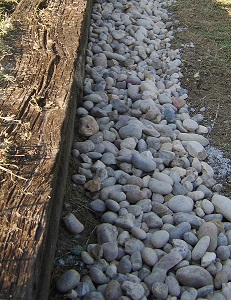 (412) 364-9114
(412) 364-9114

Do you have a soggy basement or wet spots in your yard? Calling your plumber to install a french drain may be the best answer. At its most basic level a french drain is a trench covered with gravel that redirects groundwater and surface water away from a specific area. When you contact your plumber about a french drain installation in your yard, it is important to have a well-crafted plan concerning what your drain will accomplish and where you want the water to be redirected. To better help you form a plan for your future french drain,keep these few points in mind while talking to your plumber about solving your outdoor drainage issues.
After a french drain is installed it provides water the easiest medium to flow through. Rather than fighting through soil, a french drain allows water to run through gravel, downhill at a very shallow angle to a perforated pipe at the bottom of the incline. Water can then flow freely through this pipe until it drains a good deal away from your home or lawn. Some common areas that you can have your french drain empty into include a drainage ditch, a low lying area of your property or the street.
When planning your french drainage system, the first step is to decide where you want the excess water on your property to drain to. Remember the goal of installing the french drain is to move water away from your house and foundation, not closer to it. Be courteous when choosing the place where the water will runoff. You don’t want to choose an area where the water will be directed into a neighbor’s yard or onto the pavement in front of your house. Doing so could lead to future problems with lawsuits between you and your neighbors or with the county you live in. In order to determine where best to have your new french drain lead, you can consult your local plumber for some ideas.
If your yard is already sloped, picking out the high point (drain field) and the low point (drain exit) will be much easier than if your yard was flat. If you’re not sure or you have questions about which side of your yard is the drain field you can use a level to determine which side is higher. If the slope of your yard is shallow, it is possible to increase the slope as you dig the trench for your french drain. Just remember that, in general, the drain should slope about one inch for every eight feet the drain covers.
When planning where to place your french drain, it is important to note where there may be underlying tree roots and utility lines. Cutting through the roots of the trees in your yard may damage them beyond repair and end up killing the flora around your home. Also, it is important to know what utility lines run through your yard and where they’re located. Calling 811 before you start having a plumber dig through your yard will save you from a potential issue that may cost you more money in the long run.
Standing water in your yard or basement has the potential to cause massive amounts of damage if left untreated. Contact a local plumber to talk about your options to redirect troublesome standing water.